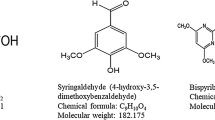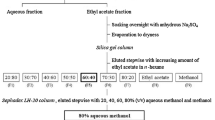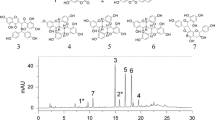Abstract
Stellera chamaejasme, a perennial weed which is an ecological threat, is widely distributed in some grasslands of Central and Eastern Asia. Our previous studies have identified several allelochemicals including two coumarins (umbelliferone and daphnoretin), from S. chamaejasme, and confirmed that allelopathy contributed to the competitive behavior of this weed. In this study, the inhibitory effects of umbelliferone and daphnoretin on lettuce seedlings and the mechanisms of their phytotoxicity were investigated. Results showed that shoot and root elongation and fresh weight of lettuce seedlings were effectively inhibited by umbelliferone in a concentration-dependent manner. Daphnoretin showed a weaker phytotoxicity. Both of the coumarins arrested the mitosis process in lettuce root tips and induced proline overproduction. Additionally, loss of cell viability and overproduction of reactive oxygen species in lettuce root cells were found after treatments with umbelliferone. Moreover, umbelliferone caused lipid peroxidation. These results suggested that umbelliferone displayed stronger phytotoxicity than daphnoretin on lettuce growth, and that the two coumarins had different mechanisms of phytotoxicity. That of daphnoretin was mainly dependent on its inhibitory effects on mitosis. Umbelliferone caused membrane lipid peroxide formation and cell death by inducing ROS overproduction, and impacted cell division, which resulted in growth inhibition of the receptor plant.





Similar content being viewed by others
Abbreviations
- DHE:
-
Dihydroethidium
- FDA:
-
Fluorescein diacetate
- FW:
-
Fresh weight
- MDA:
-
Malondialdehyde
- MI:
-
Mitosis index
- PCD:
-
Program cell death
- PI:
-
Propidium iodide
- ROS:
-
Reactive oxygen species
References
Abenavoli MR, Sorgonà A, Sidari M, Badiani M, Fuggi A (2003) Coumarin inhibits the growth of carrot (Daucus carota L. cv. Saint Valery) cells in suspension culture. J Plant Physiol 160:227–237
Apel K, Hirt H (2004) Reactive oxygen species: metabolism, oxidative stress, and signal transduction. Annu Rev Plant Biol 55:373–399
Baker CJ, Mock NM (1994) An improved method for monitoring cell death in a cell suspension and leaf disk assays using Evans blue. Plant Cell Tiss Org Cult 39:7–12
Bates L, Waldren RP, Teare ID (1973) Rapid determination of free proline for water stress studies. Plant Soil 39:205–207
Chuang JY, Huang YF, Lu HF, Ho HC, Yang JS, Li TM, Chang NW, Chung JG (2007) Coumarin induces cell cycle arrest and apoptosis in human cervical cancer HeLa cells through a mitochondria- and caspase-3 dependent mechanism and NF-κB down-regulation. In vivo 21:1003–1010
Cui HY, Jin H, Liu Q, Yan ZQ, Ding L, Qin B (2014) Nematicidal metabolites from roots of Stellera chamaejasme against Bursaphelenchus xylophilus and Bursaphelenchus mucronatus. Pest Manag Sci 70:827–835
Cullen JJ, Hinkhouse MM, Grady M, Gaut AW, Liu J, Zhang Y, Weydert CJD, Domann FE, Oberley LW (2003) Dicumarol inhibition of NADPH: quinone oxidoreductase induces growth inhibition of pancreatic cancer via a superoxide-mediated mechanism. Cancer Res 63:5513–5520
Frew JE, Jones P, Scholes G (1983) Spectrophotometric determination of hydrogen peroxide and organic hydropheroxides at low concentrations in aqueous solution. Anal Chim Acta 155:139–150
Garnczarska M (2005) Response of the ascorbate-glutathione cycle to re-aeration following hypoxia in lupine roots. Plant Physiol Biochem 43:583–590
Goodwin RH, Taves C (1950) The effect of coumarin derivatives on the growth of Avena roots. Am J Bot 37:224–231
Guo HR, Cui HY, Jin H, Yan ZQ, Ding L, Qin B (2015) Potential allelochemicals in root zone soils of Stellera chamaejasme L. and variations at different geographical growing sites. Plant Growth Regul 77:335–342
Hao W, Zhang X, Zhao W, Chen X (2014) Psoralidin induces autophagy through ROS generation which inhibits the proliferation of human lung cancer A549 cells. PeerJ 2:e555
Hodges DM, DeLong JM, Forney CF, Prange RK (1999) Improving the thiobarbituric acid-reactive-substances assay for estimating lipid peroxidation in plant tissues containing anthocyanin and other interfering compounds. Planta 207:604–611
Jankay P, Muller WH (1976) The relationships among umbelliferone, growth, and peroxidase levels in cucumber roots. Am J Bot 63:126–132
Katsuhara M, Otsuka T, Ezaki B (2005) Salt stress-induced lipid peroxidation is reduced by glutathione S-transferase, but this reduction of lipid peroxides is not enough for a recovery of root growth in Arabidopsis. Plant Sci 169:369–373
Ko CH, Shen SC, Chen YC (2004) Hydroxylation at C4′ or C6 is essential for apoptosis-inducing activity of flavanone through activation of the caspase-3 cascade and production of reactive oxygen species. Free Radic Biol Med 36:897–910
Koodkaew I, Sunohara Y, Matsuyama S, Matsumoto H (2012) Phytotoxic action mechanism of hapalocyclamide in lettuce seedlings. Plant Physiol Biochem 58:23–28
Ma Y, Zhou Y, Xie C, Chen D, Li J (2012) Novel microtubule-targeted agent 6-chloro-4-(methoxyphenyl) coumarin induces G2-M arrest and apoptosis in HeLa cells. Acta Pharmacol Sin 33:407–417
Makepeace W, Dobson AT (1985) Interference phenomena due to mouse-ear and king devil hawkweed. N Z J Bot 23:79–90
Morikawa CIO, Miyaura R, Kamo T, Hiradate S, Perez JAC, Fujii Y (2011) Isolation of umbelliferone as a principal allelochemical from the Peruvian medicinal plant Diplostephium foliosissimum (Asteraceae). Rev Soc Quím Perú 77:285–291
Nebo L, Varela RM, Molinillo JMG, Sampaio OM, Severino VGP, Cazal CM, Fernandes MFG, Fernandes JB, Macías FA (2014) Phytotoxicity of alkaloids, coumarins and flavonoids isolated from 11 species belonging to the Rutaceae and Meliaceae families. Phytochem Lett 8:226–232
Pan J, Zhu M, Chen H (2001) Aluminum-induced cell death in root-tip cells of barley. Environ Exp Bot 46:71–79
Pan L, Li XZ, Yan ZQ, Guo HR, Qin B (2015) Phytotoxicity of umbelliferone and its analogs: structure-activity relationships and action mechanisms. Plant Physiol Biochem 97:272–277
Pollock BM, Goodwin RH, Greene S (1954) Studies on roots. II. Effects of coumarin, scopoletin and other substances on growth. Am J Bot 41:521–529
Razavi SM (2011) Plant coumarins as allelopathic agents. Int J Biol Chem 5:86–90
Reape TJ, Molony EM, McCabe PF (2008) Programmed cell death in plants: distinguishing between different modes. J Exp Bot 59:435–444
Sharma OP, Sharma S, Pattabhi V, Mahato SB, Sharma PD (2007) A review of the hepatotoxic plant Lantana camara. Crit Rev Toxicol 37:313–352
Shettel NL, Balke NE (1983) Plant growth response to several allelopathic chemicals. Weed Sci 31:293–298
Shimomura H, Sashida Y, Nakata H, Kawasaki J, lto Y (1982) Plant growth regulators from Heracleunr lanatunr. Photochemistry 2(l):2213–2215
Szabados L, Savoure A (2010) Proline: a multifunctional amino acid. Trends Plant Sci 15:89–97
Veselin P, Jacques H, Bernd MR, Savov GT (2015) ROS-mediated abiotic stress-induced programmed cell death in plants. Front Plant Sci 6:e69
Yamamoto Y, Kobayashi Y, Devi SR, Rikiishi S, Matsumoto H (2002) Aluminum toxicity is associated with mitochondrial dysfunction and the production of reactive oxygen species in plant cells. Plant Physiol 128:63–72
Yan ZQ, Guo HR, Yang JY, Liu Q, Jin H, Xu R, Cui HY, Qin B (2014) Phytotoxic flavonoids from roots of Stellera chamaejasme L. (Thymelaeaceae). Phytochemistry 106:61–68
Yan ZQ, Wang DD, Ding L, Cui HY, Jin H, Yang XY, Yang JS, Qin B (2015) Mechanism of artemisinin phytotoxicity action: induction of reactive oxygen species and cell death in lettuce seedlings. Plant Physiol Biochem 88:53–59
Yang JY, Yan ZQ, Xu R, Liu Q, Jin H, Cui HY, Qin B (2011) Isolation of plant growth inhibitory components from the root of Stellera chamaejasme and function mechanism. Acta Bot Boreal Occident Sin 31:0291–0297
Yaoya S, Kanho HY, Itani T, Umehara K, Kuroyanagi M (2004) Umbelliferone released from hairy root cultures of Pharbitis nil treated with copper sulfate and its subsequent glucosylation. Biosci Biotechnol Biochem 68:1837–1841
Yu S, Hu D, Zhang J (2015) Umbelliferone exhibits anticancer activity via the induction of apoptosis and cell cycle arrest in HepG2 hepatocellular carcinoma cells. Mol Med Rep 12:3869–3873
Zhang ZQ, Zhang YH, Sun H (2011) The reproductive biology of Stellera chamaejasme (Thymelaeaceae): a self-incompatible weed with specialized flowers. Flora 206:567–574
Acknowledgments
This work was financially supported by the National Natural Science Foundation of China (No. 31300290, 21302195 and 31570354), CAS "Light of West China" Program, Agricultural Biotechnology Research and Development Program of Gansu Province (GNSW-2015-25), Cooperation Program to Gansu Province of Lanzhou Branch of the Chinese Academy of Sciences, and the Open Project of Key Laboratory for Tobacco Gene Resources, Institute of Tobacco Research, Chinese Academy of Agricultural Sciences.
Author information
Authors and Affiliations
Corresponding author
Additional information
Communicated by A. Gniazdowska-Piekarska.
Rights and permissions
About this article
Cite this article
Yan, Z., Wang, D., Cui, H. et al. Phytotoxicity mechanisms of two coumarin allelochemicals from Stellera chamaejasme in lettuce seedlings. Acta Physiol Plant 38, 248 (2016). https://doi.org/10.1007/s11738-016-2270-z
Received:
Revised:
Accepted:
Published:
DOI: https://doi.org/10.1007/s11738-016-2270-z




